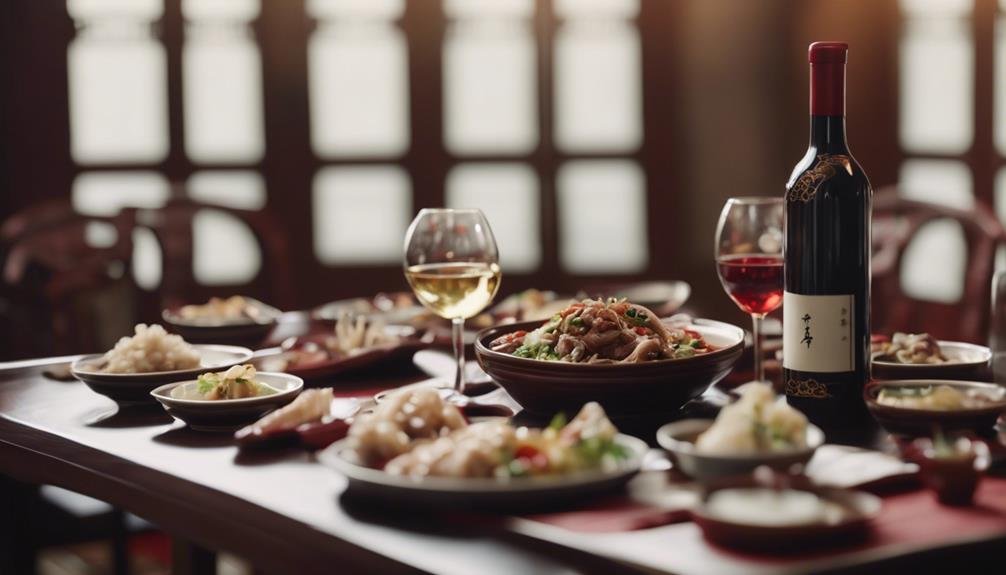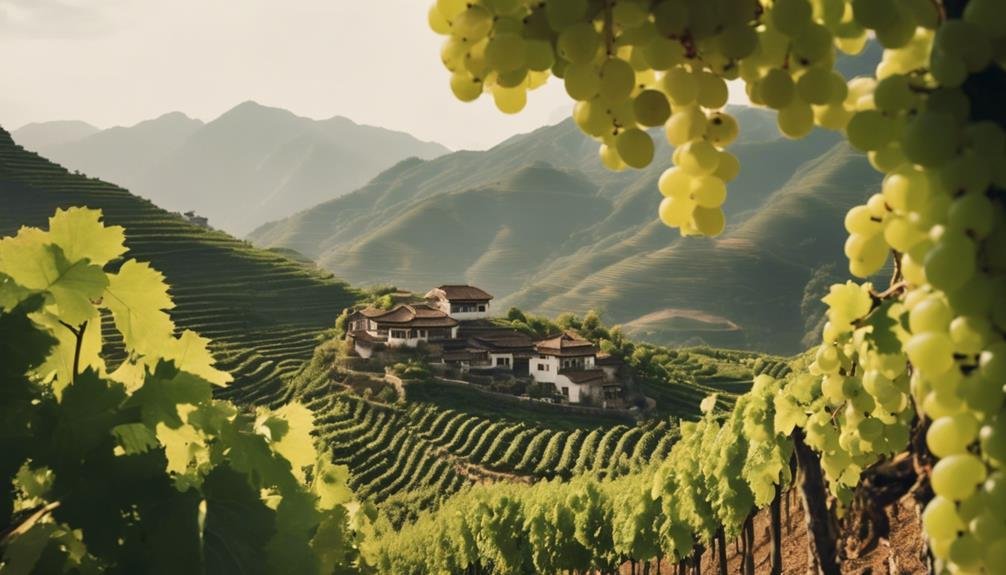The Chinese wine industry is flourishing, with Xinjiang, Yunnan, and Ningxia as key regions. French winemaking techniques have deeply influenced China since the 1980s, enhancing quality and establishing unique regional styles. Chinese wine pairing focuses on balance and tradition, with preferences for aromatic whites and robust reds like Cabernet Sauvignon. Innovation thrives in the evolving landscape, with a focus on terroir and sustainability. Chinese wines, recognized globally for their distinctive qualities, are expanding into new markets. The dynamic fusion of regions, trends, and influences crafts impressive wines poised for continued success.
Emerging Wine Regions in China
In recent years, several emerging wine regions in China have garnered attention for their unique terroirs and promising viticultural potential. These regions are actively engaged in terroir exploration and cultivation of diverse grape varietals. Areas like Xinjiang, Yunnan, and Ningxia are at the forefront of this movement, showcasing their ability to produce high-quality wines that reflect the distinct characteristics of their respective terroirs.
Xinjiang stands out for its grapes with high sugar content, while Yunnan's Himalayan terroir displays promising signs for quality wine production. Additionally, Ningxia's focus on Bordeaux varieties and its own wine classification system highlight the region's dedication to producing exceptional wines.
These emerging regions are contributing significantly to the growth and diversification of the Chinese wine industry.
Influence of French Winemaking
French winemaking techniques have profoundly shaped the evolution of the Chinese wine industry, influencing both production practices and quality standards. The historical roots of French winemaking influence in China can be traced back to the early 1980s when the modern Chinese wine industry began to take shape.
Chinese winemakers looked to France, known for its prestigious wine culture, for guidance on grape cultivation, fermentation methods, and aging processes. This influence led to the adoption of traditional French winemaking practices in Chinese vineyards and wineries, contributing to the enhancement of wine quality and the establishment of recognizable regional styles.
As a result, the integration of French winemaking techniques has played a pivotal role in positioning Chinese wines on the global wine map.
Chinese Wine Pairing Preferences

The Chinese wine industry showcases a distinctive preference for wine pairings that complement the rich and diverse flavors of traditional Chinese cuisine. When it comes to Chinese wine and spice pairings, the following traditional practices are commonly observed:
- Emphasis on balancing flavors through wine selection.
- Preference for aromatic white wines with spicy dishes.
- Red wines like Cabernet Sauvignon often paired with hearty meat dishes.
- Traditional Chinese wine etiquette values serving wine at appropriate temperatures.
These preferences reflect not only the culinary traditions but also the cultural significance attached to food and wine interactions in Chinese dining settings. By understanding these pairings and etiquettes, one can fully appreciate the harmonious relationship between Chinese wines and the intricate flavors of Chinese cuisine.
Notable Trends in Chinese Winemaking
Emphasizing the evolving landscape of Chinese winemaking practices, recent trends in the industry reflect a dynamic shift towards innovative techniques and a focus on terroir-driven production methods. Sustainable practices have gained prominence, with wineries implementing eco-friendly initiatives to minimize environmental impact.
Innovative techniques such as precision viticulture and state-of-the-art winemaking equipment are being adopted to enhance quality and consistency. Chinese winemakers are increasingly exploring unique grape varietals suited to local terroirs, showcasing the diversity and potential of the country's wine regions.
This commitment to sustainability and innovation not only elevates the quality of Chinese wines but also positions the industry for continued growth and success on the global stage.
Global Recognition of Chinese Wines

With an expanding global presence, Chinese wines are gaining increasing recognition for their unique characteristics and quality standards.
- International recognition: Chinese varietals are earning praise on the global stage for their distinct flavors and profiles.
- Growing export market: Chinese wineries are expanding their reach into international markets, showcasing the diversity and quality of Chinese wines.
- Quality standards: Chinese winemakers are focusing on improving quality standards to meet the demands of the global wine community.
- Recognition for innovation: Chinese wineries are being acknowledged for their innovative approaches to winemaking, pushing boundaries and creating new experiences for wine enthusiasts worldwide.
Frequently Asked Questions
How Does the Chinese Government Support Small Wineries in Emerging Regions?
Government support for small wineries in emerging regions involves financial incentives, technical assistance, and marketing guidance. This aid fosters regional development by boosting infrastructure, enhancing quality standards, and promoting diverse terroirs, ultimately elevating the profile of these wineries.
What Unique Challenges Do Winemakers in Xinjiang Face Due to Transportation Difficulties?
What hurdles do Xinjiang winemakers navigate due to transportation constraints? The vast distances and rugged terrain in Xinjiang pose logistical challenges in transporting grapes and wines, impacting timely deliveries and maintaining product integrity.
Are There Any Specific Grape Varieties That Thrive in Yunnans Himalayan Terroir?
Grape varieties thriving in Yunnan's Himalayan terroir include Cabernet Sauvignon, Merlot, and Marselan. Winemakers face unique challenges due to transportation difficulties, impacting the region's grape quality and production efficiency. Overcoming these obstacles is essential for Yunnan's wine industry development.
How Do Chinese Winemakers Incorporate the Bell Pepper Flavor Profile in Their Wines?
In wine fermentation, Chinese winemakers utilize specific yeast strains and fermentation temperatures to evoke bell pepper flavors. Flavor development is influenced by grape variety and terroir characteristics. This process highlights the artistry and precision of Chinese winemaking.
What Initiatives Are in Place to Promote Chinese Wine Exports to Global Markets?
To promote Chinese wine exports to global markets, initiatives focus on strategic export strategies, market penetration, branding efforts, and participation in international competitions. These activities enhance visibility, credibility, and competitiveness in the international wine arena.
Conclusion
To sum up, the Chinese wine industry continues to evolve and make its mark on the global stage, blending tradition with innovation to produce unique and flavorful wines.
With diverse regions, influences from French winemaking, and evolving consumer preferences, Chinese wines are gaining global recognition.
As the industry grows and matures, it will be interesting to see how Chinese wines continue to shape the global wine market with their distinct characteristics and growing popularity.
